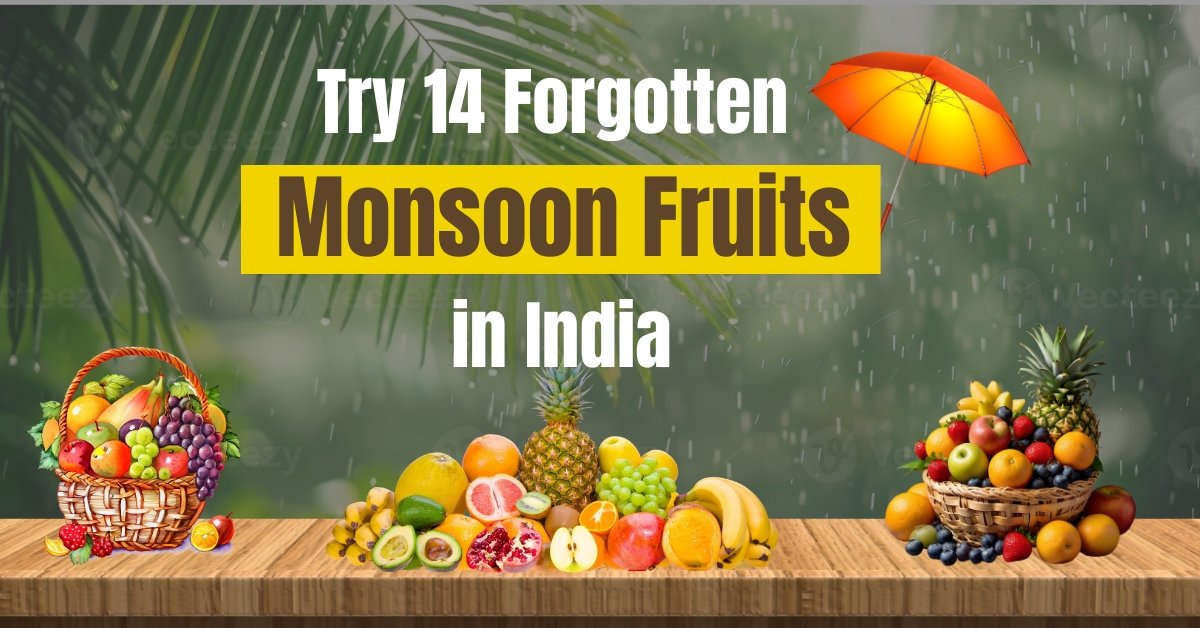
Try 14 Forgotten Rainy/Monsoon Fruits Our Ancestors Loved
Monsoon Fruits | Rainy Season Fruits | Seasonal Fruits Benefits | Homemade Bael Juice Recipe | Traditional Fruits
Monsoon is more than just rain—it’s a season of unique, nutrient-rich monsoon fruits that our ancestors cherished. Rainy days bring so much nostalgia from kids to adults, kids are happy because of holidays and adults take advantage of the monsoon fruits that help them to fight with the viral infections. Rediscover these traditional monsoon fruits gems: Falsa, Satoot, Nakha, Jamun, and Alubukhara. Each offers a blend of flavor, nostalgia, and health benefits.
Read More: 7 Fresh Monsoon/Summer Fruits to Eat and Benefits to Health
Here are some lesser-known, almost forgotten monsoon fruits that older generations used to eat but are rarely heard of today:
- Falsa (Indian Sherbet Berry) फालसा

– Falsa is a small, tangy berry, perfect for cooling off on humid days. Packed with water, vitamin C, and antioxidants, it hydrates, boosts immunity, and helps manage blood sugar levels. Its natural cooling effect makes it a classic summer and monsoon fruit, ideal for juices and snacks.
- Satoot (Shahtoot/Mulberry) शहतूत

– Satoot, or mulberry, is a juicy, sweet monsoon fruit once common in Indian households. Rich in vitamins C, A, E, and K, as well as iron and calcium, it supports immunity, bone health, and even brain function. Mulberries were also used in traditional medicine to treat infections and digestive issues.
- Nakha (Nakh Pear) नाशपाती
– Nakha pears are crisp, mildly sweet, and loaded with vitamin C, vitamin K, potassium, and fiber. They help regulate blood pressure, support digestion, and provide antioxidants like quercetin, which may reduce inflammation and promote heart health. Enjoy them fresh or in salads during the monsoon.
- Jamun (Indian Blackberry) जामुन
– Jamun is a monsoon superfood, known for its deep purple color and tangy-sweet taste. It cools the body, aids digestion, and is especially valued for managing blood sugar. Rich in vitamins A and C, iron, and antioxidants, jamun helps boost immunity and supports overall wellness.
- Alubukhara (Plum/Prune)
– Alubukhara, or dried plum, is both tangy and sweet. Traditionally used as a laxative and digestive aid, it is abundant in fiber, vitamin C, and antioxidants. The rainy/monsoon fruit is gentle on the stomach and supports healthy digestion, making it a favorite in Unani and Ayurvedic traditions.
- Soh-shang (Silverberry): A wild forest monsoon fruit found in Meghalaya, known for its seasonal availability and unique flavor.
- Soh-phie (Bay-berry) and Soh-myndong (Burmese grapes):

Forgotten Monsoon Fruits Wild monsoon fruits from the Khasi-Jaintia region, enjoyed locally during summer and monsoon.
- Memang Narang (Indian wild orange, Citrus indicia): A primitive citrus variety native to Garo Hills, now rare due to hybrid cultivation.
- Bimbul (Cucumber tree fruit): Small tart fruits used in pickles and chutneys, common in Belagavi monsoon cuisine.
- Vaghate (Govind phal): A green, seed-filled fruit offered in Maharashtra during Ashadhi Ekadashi, valued for its medicinal properties during monsoon.
- Taal (Palmyra palm fruit): Used in Bengali rainy/monsoon sweets like taaler bora, deeply rooted in local tradition.
- Madras Thorn (Jungle jalebi): A pod-like fruit with mild tartness and sweetness, eaten seasonally.
- Indian Hog Plum (Amra/Ambade): A sour-sweet fruit consumed in parts of India during monsoon, rich in vitamin C.
- Bael (Wood apple):

Bael Fruit known as Monsoon Fruits A hard-shelled fruit with aromatic, cooling pulp, used traditionally as sherbet and medicine during hot and monsoon seasons.
Why Bring Back Rainy/Monsoon Fruits?
– Natural Hydration: High water content keeps you refreshed during muggy monsoon days.
– Immunity Boost: Rich in vitamins and antioxidants to help fight seasonal infections.
– Digestive Health: Many of these fruits aid digestion and prevent common monsoon ailments.
– Sustainable & Local: Reviving these fruits supports local farmers and preserves biodiversity.
Rediscover these forgotten monsoon fruit treasures and enjoy the flavors and wellness secrets our ancestors celebrated.
These fruits are part of indigenous diets and monsoon rituals but have largely disappeared from urban markets and modern diets, making them true “forgotten” rainy/monsoon fruits worth rediscovering.
Wrapping Up
Monsoon fruits are not just seasonal treats—they’re nature’s way of helping us stay healthy during the rainy season. Rich in essential vitamins like A and C, these fruits strengthen the immune system, support glowing skin, and aid digestion with their high fiber content. Antioxidants in fruits like peaches further protect the body from harmful free radicals, ensuring overall wellness.
By incorporating the top 10 monsoon fruits into your daily diet, you can enjoy a flavorful, nutrient-rich way to stay energized, fight seasonal infections, and uplift your mood. Each rainy/monsoon fruit brings its own unique taste and health benefits, making your monsoon plate both vibrant and wholesome. So this rainy season, embrace the goodness of monsoon fruits—stay refreshed, stay nourished, and let health pour in with every juicy bite!





